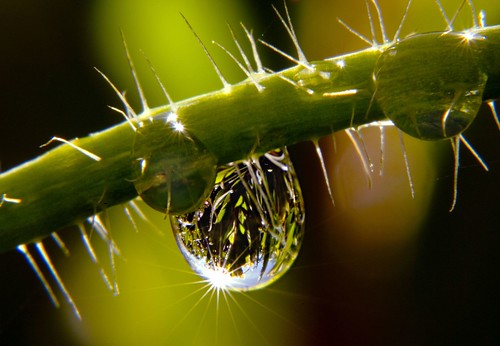From time to time I repost from my archives. This is a reposting of images and a story originally published in July 2006.

The force that through the green fuse, photo by Harold Davis. View this photograph larger.
I get asked all the time how I make my water drop photos. For example:
I’ve seen many of your photographs and am really impressed with all the water drops. I’d like to know how you do it, and specifically what lens you use.
There really is no one answer to this question. Water drop photography is macro photography with some subject-matter specific difficulties. Macro photography in and of itself is one of the most technically difficult kinds of photography because once you get really close to a small object inherently shallow depth-of-field, precise focus, and motion—even the slightest motion—are all issues that can defeat a photograph, no matter how beautiful it would be otherwise.
What makes water drop photography a bit more difficult than run-of-the-mill photography of very small subjects is the extreme reflectivity of a water drop and the fact that a water drop is in almost constant motion (read more about these issues here).
In this story, I’ll address the equipment I use—and tackle some of the other technical issues related to water drop photography in future stories.
I use Nikon digital SLR equipment, right now a Nikon D200 body. As far as I am concerned, there’s no saying this is any better than any other brand, it is just what I happen to use. (For example, Canon is probably just as good.)
It’s also worth saying upfront that one can take perfectly good macro photographs with relatively primitive equipment provided the camera has a macro mode. For example, check out this photo of wedding rings that I took with a Canon Powershot G3. To get good results, you do need to be sure you are using a tripod, and know how to get the maximum depth-of-field from the camera.
My macro lens are a Nikon 200mm f/4 (used with the photograph above), a Nikon 105mm f/2.8 (the older, non-VR model), and a Sigma 50mm f/2.8. I often use Kenko extension tubes (I have two sets) with these lenses. I prefer these to the Nikon extension tubes because they retain automatic exposure in Aperture-preferred mode. Besides the extension tubes, I have close-up filters for these lenses, a lens reversal mount for the 105mm lens, and a Nikon PK-6 bellows.
I always focus macro lenses manually, and I use a magnifying eye piece for added precision.
I sometimes handhold macro shots with extension tubes and/or close-up lens and a VR (vibration reduction, also called image stabilization) zoom lens, like my 18-200mm Nikon zoom. (Here’s a photo taken with this technique.)
But most of the time I use one of my macro lenses, and these are invariably tripod shots, most often at the maximum possible depth-of-field, using mirror lock-up and the Nikon MC-36 remote to trigger the shutter.
I think my tripod is probably my most important piece of equipment. It is likely to outlast my D200, and probably most of the lenses I currently use as well. My tripod is a carbon-fiber Gitzo MK-2, which combines light weight with strength and agility.
To strobe or not to strobe, that is the question. Using flash as a light source with water drops replaces the natural light source with that created by the strobe (read more about this). When I do use flash with water drops, I use the Nikon wireless R1 close-up kit, which includes two Nikon wireless remote SB-R200 units. I also sometimes use a SU-800 unit connected via wireless to supply additional ambient light.
Leaving the hardware of photography aside for a second, my title for the photograph that started this story is “The force that through the green fuse,” after the Dylan Thomas poem. Here’s the first stanza of the poem:
The force that through the green fuse drives the flower
Drives my green age; that blasts the roots of trees
Is my destroyer.
And I am dumb to tell the crooked rose
My youth is bent by the same wintry fever.
My point being: that at its best, photography of water drops, like all good art, is about the creative life force, the urges that make us live, breath, yearn and die. A powerful force runs through each water drop, but all too soon (from the photographer’s viewpoint) each drop ends in falling or evaporation, with new worlds to live or die wherever one’s lens is pointed next. Water drop photography is about capturing the brief life of an ephemeral and tiny world.